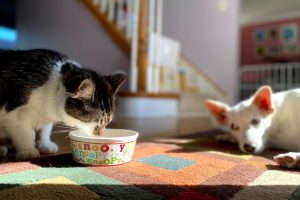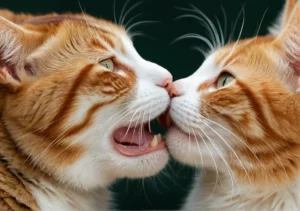Cats are known for their unique and rough tongues, but have you ever wondered why they have this distinct feature? Let’s explore the fascinating reason behind why cats’ tongues are so rough.
The Anatomy of a Cat’s Tongue
Have you ever wondered why cats tongues feel like sandpaper? It’s all thanks to the tiny, hook-like structures on their tongues called papillae. These papillae are made of keratin, the same material that makes up our fingernails. Imagine having a bunch of mini-hooks on your tongue – that’s cat life in a nutshell!
These papillae serve a specific purpose for our feline friends. They help them groom themselves by acting like a comb, removing dirt, debris, and loose fur from their coat. So, the next time you see your cat giving itself a bath, remember it’s not just for hygiene – it’s also for exfoliation!
Why Do Cats Have Rough Tongues?
So, why did cats evolve to have such rough tongues in the first place? Well, think about it – cats are natural-born hunters. Their rough tongues actually help them catch and eat their prey more efficiently. When a cat licks its fur, those papillae not only clean but also help to strip the meat off their prey’s bones. It’s like having a built-in utensil for tearing and shredding!
Additionally, the rough texture of their tongues helps cats lap up water more effectively. It creates a sort of mini ladle effect, allowing cats to drink swiftly and efficiently. So, the next time you see your cat grooming itself or lapping up water, appreciate the incredible evolutionary design that makes it all possible.
Grooming Behavior
Cats have rough tongues for a reason – it’s not just for giving you those unexpected scratches during affectionate moments. Their tongues are covered in tiny, hook-like structures called papillae that act as natural combs. These papillae help cats efficiently groom themselves by removing dirt, debris, and loose fur from their coats.
Additionally, the rough texture of a cat’s tongue helps distribute their natural oils throughout their fur, keeping it shiny and healthy. So, next time you see your feline friend meticulously grooming themselves, remember that their rough tongue is a vital tool in keeping them clean and well-groomed.
Feeding Behavior
Have you ever noticed how cats seem to be masterful at extracting every last bit of meat from a bone? Well, their rough tongues play a crucial role in this feeding behavior. The tiny backward-facing hooks on their tongues help cats rasp meat off bones, making it easier for them to consume their prey efficiently.
In the wild, this skill is essential for survival, as it allows cats to extract as much nutrition as possible from their food. So, the next time you watch your cat savoring a meal, appreciate the purpose behind their uniquely rough tongue – it’s a key tool that helps them thrive in their natural hunting instincts.
Communication
A cat’s rough tongue plays a crucial role in communication with other cats. When grooming each other, cats lick to clean and bond. The rough texture helps remove dirt and debris from their fur, maintaining hygiene. Additionally, a mother cat uses her rough tongue to groom her kittens, showing care and affection. Cats also use their tongues to communicate with their humans. A gentle lick may indicate affection or a request for attention. Understanding and reciprocating this behavior strengthens the bond between you and your feline friend.
Unique Features
Did you know that a cat’s tongue is covered in tiny, hook-like structures called papillae? These papillae give the tongue its rough texture and serve various purposes. One interesting fact is that the rough surface helps cats rasp meat off bones, making them efficient hunters. Another unique feature is that a cat’s tongue is essential for grooming, as it acts like a natural comb to detangle fur and distribute oils. Moreover, the barbs on a cat’s tongue help them lap up water efficiently by creating a column of liquid to swallow, unlike dogs that use a different method. Embrace the fascinating intricacies of your feline companion’s rough tongue.
Fun Trivia
Did you know that a cat’s tongue is covered in tiny, hook-like structures called papillae? These papillae are made of keratin, the same protein found in our fingernails and hair, making them tough and scratchy. These tiny hooks help cats groom themselves by acting like a comb, removing dirt, debris, and loose fur from their coats. Next time you see your cat giving itself a bath, just remember it’s using its rough tongue to stay clean and healthy!
Conclusion
A cat’s rough tongue is a fascinating and crucial part of their biology. Not only does it help them groom and stay clean, but it also serves other purposes, such as aiding in the consumption of their prey in the wild. Understanding why cats have rough tongues gives us a deeper appreciation for the unique and incredible abilities of these fascinating animals. So next time your cat gives you a gentle lick with their scratchy tongue, remember it’s just their way of showing affection and taking care of themselves.
Alex, a passionate animal lover, has experience in training and understanding animal behavior. As a proud pet parent to two dogs and three cats, he founded AnimalReport.net to share insights from animal experts and expand his knowledge of the animal kingdom.




